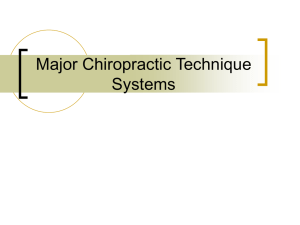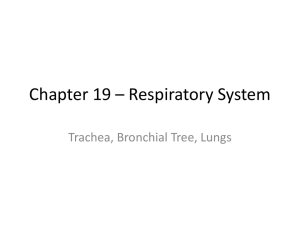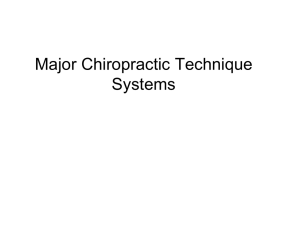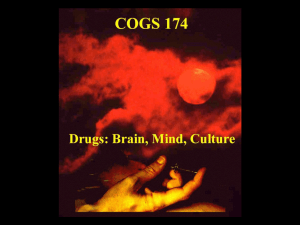ANATOMY OF TRACHEOBRONCHIAL TREE
advertisement
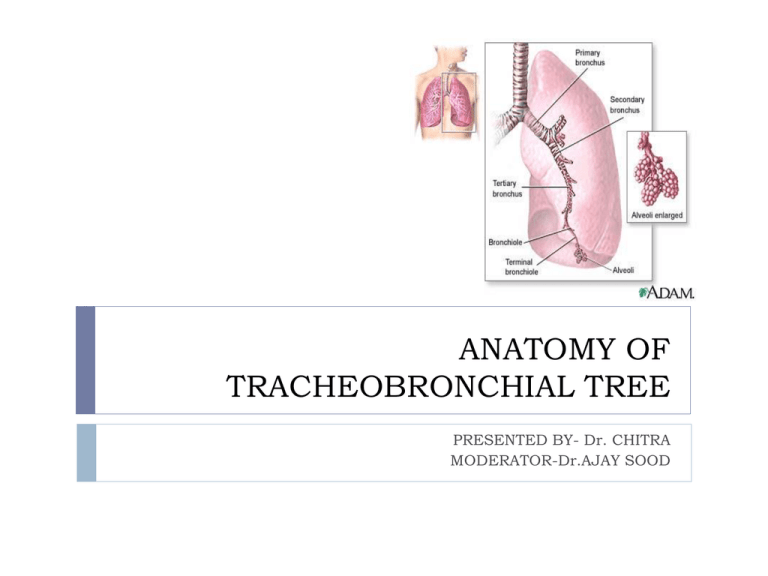
ANATOMY OF TRACHEOBRONCHIAL TREE PRESENTED BY- Dr. CHITRA MODERATOR-Dr.AJAY SOOD Respiratory System TRACHEA It is a cartilaginous and membranous tube EXTENT - from 6th cervical vertebra till the body of 5th thoracic vertebra During expiration the bifurcation rises by one vertebral level and during inspiration may be lowered as far as 6th thoracic vertebra LENGTH - 11cm DIAMETER - 2 to 2.5cm CHILDREN - smaller, deeper, more moveable STRUCTURE CARTILAGES-16to20 in no.,each forms an incomplete ring,which occupies anterior two third of circumference of trachea Are placed horizontally above each other,separated by narrow intervals 4mm deep and 1mm thick Outer surface is flattened in vertical direction and convex from inner side Highly elastic,but may calcify in later stages FIRST TRACHEAL CARTILAGE-broader,divided connected to lower end of cricoid by cricotracheal ligament LAST TRACHEAL CARTILAGE-thick and broad in midlle, lower border is prolonged to a triangular hook shaped process which curves downward and backward between two bronchi FIBROUS MEMBRANE-cartilages are enclosed in an elastic fibrous membrane which consists of two layers,one passes over the outer surface the other one over the inner surface At upper and lower margins they blend together to form a single membrane MUSCULAR TISSUES-two layers of non –striated muscles longitudinal and transeverse Longitudinal fibres are external,consist of few scattered bundles only Transeverse fibers(trachealis muscle) are internal,extends between the end of cartilages MUCUS MEMBRANE-continous above with larynx and below with bronchus Consist of areolar and lymphoid tissue,basement membrane,supporting stratified epithelium ,surface layer of which is columnar and ciliated Beneath basement membrane there is a layer of longitudinal elastic fibre Submucus layer,composed of loose meshwork of connective tissue VESSELS AND NERVES ARTERIAL SUPPLY-Inferior thyroid arteries NERVE SUPPLY-vagus nerve,recurrent nerve,sympathetic nerves RIGHT BRONCHUS 2.5cm long Wider,shorter,more vertical Divides into EPARTERIAL and HYPARTERIAL BRONCHUS based on right pulmonary artery RIGHT UPPER LOBE BRONCHUS It divides into three segmental bronchi which supply apical,anterior and posterior segments of upper lobe APICAL SEGMENTAL BRONCHUS-divides into apical and anterior subsegmental branches POSTERIOR SEGMENTAL BRONCHUS-divides into lateral and anterior subsegmental branches. It serves the posteroinferior part of superior lobe of lung ANTERIOR SEGMENTAL BRONCHUS-runs anteroinferiorly to supply rest of the part of upper bronchus. Divides into lateral and anterior subsegmental branches RIGHT MIDDLE LOBE BRONCHUS Divides into lateral and medial subsegments RIGHT LOWER LOBE BRONCHUS Continuation of principal stem beyond the origin of middle lobe bronchus Supplies 5 segments of the lung Apical segmental bronchus Medial basal segmental bronchus Anterior basal segmental bronchus Lateral and posterior basal segmental bronchus LEFT BRONCHUS 5cm in length Smaller in caliber Enters the lung opposite 6th thoracic vertebra RELATIONS-passes beneath the aortic arch,crosses in front of oesophagus,thoracic duct,descending aorta,has left pulmonary artery at first above and then in front LEFT UPPER LOBE BRONCHUS Cranially it divides into anterior ,apical and posterior segmental branches Caudally into superior and inferior lingual branches LEFT LOWER LOBE BRONCHUS Divides into apical segmental bronchus,medial basal,anterior basal,lateral and posterior basal branches BRONCHI • Right bronchus - – Wider – More vertical – shorter – Supported by C shaped cartilages – 20-30 degree angle – First generation • Left bronchus – Narrower – More angular – Longer – Supported by C shaped cartilages – 40-60 degree angle – First generation CLINICAL SIGNIFICANCE Right main bronchus is more in line with trachea Inhaled foreign bodies and gastric contents enter right bronchial tree If patient is lying on his side,lateral subsegments of anterior and posterior segments are more likely to get such material If patient is supine,then apical segmental bronchus which arise from right or left lower lobe bronchus is the most common part of lung for the aspirated material to collect BRONCHOPULMONARY SEGMENTS Anatomic,functional and surgical units of lung 23 divisons or generations are involved in dichotomous division,starting from trachea till alveolar sacs Each lobar bronchus(secondary bronchus) gives off branches called segmental bronchus(tertiary bronchus) As bronchi become smaller, cartilages also become smaller and fewer in no Bronchioles are formed which are less then 1mm in dia,no cartilages and lined by ciliated columnar epithelium Divide to form terminal bronchioles,which show delicate outpouchings from their wall These are respiratory bronchioles,dia is 0.5mm,they end by branching into alveolar ducts Each alveolar sac consist of around 17 alveoli Each alveolus surrounded by rich network of blood capillaries Gas exchange primarily occurs on thin side of alveolocapillary membrane,thick side provides structural support ALVEOLI Type I pneumocyteslarge flattened cells, present a very thin diffusion barrier for gases Type II pneumocytessecretes surfactant,which decreases the surface tension between thin alveolar walls macrophages Subdivision of lung lobe Pyramid shaped,apex towards lung root Surrounded by connective tissue Segmental bronchus,segmental artery,lymph vessels and autonomic nerves Segmental vein lies between adjacent segments BLOOD SUPPLY OF LUNGS By bronchial arteries which are branches of descending aorta NERVE SUPPLY OF LUNGS Pulmonary plexus-efferent and afferent autonomic nerve fibres Sympathetic efferent fibres produce bronchodilation and vasoconstriction Parasympathetic efferent produces bronchoconstriction,vasodilation,increase glandular secretions

